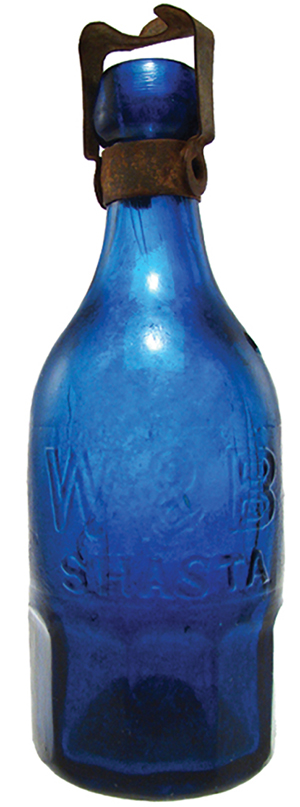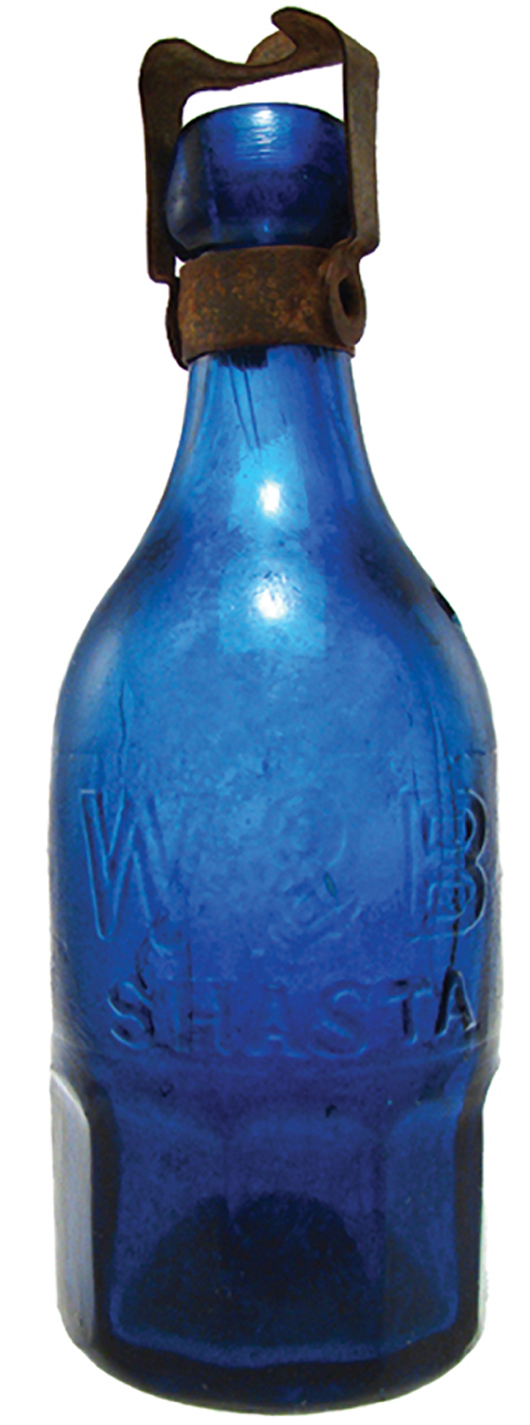
A window shelf that holds a collection of cobalt-blue bottles attracts attention, so many new collectors buy their bottles by color. Most early bottles were made of pale-blue or aqua glass. It was difficult to produce clear glass in the 18th and early 19th centuries. Early bottles were blown, sometimes shaped by the maker or sometimes blown into an iron mold. A bottle had small imperfections caused by tiny pieces of sand or other ingredients. Dark colors were rare. By 1880, the quality of glass was improving. Whittle marks and tiny bubbles were seen less often, and chemicals were added to make colored glass smooth. Amber, green, brown, light-blue and clear bottles were made to hold medicine, whiskey, soda, ink, mineral water and canned food.
The most popular cobalt-blue color was made by adding cobalt oxide to the glass mixture. The automatic bottling machine came into use in 1903, so cobalt-blue bottles seen most often today were machine-made. Many held medicine, like Bromo-Seltzer or Milk of Magnesia.These are very inexpensive. But old cobalt bottles made earlier can be worth hundreds of dollars. Buying tips: Old bottles probably have pontil marks (a pontil mark is a scar on the bottom), flaws and raised lettering identifying the contents or maker. Many new cobalt-blue figural bottles have been made. Bottles marked “Wheaton” on the bottom are new. There are cobalt-blue bottles in stores today that hold water or vodka.
Q: We have a cast-iron wood-burning stove in our garage that we salvaged from an old cabin. The markings on it read, “Lakeside Foundry Co., Chicago, Ill., Bell-Wood, Windsor.” Can you tell us anything about it?
A: Lakeside Foundry Co. was in business from about 1902 until 1920, when the foundry was sold and the name became Lakeside Forge. Lakeside Foundry made stoves, bells, tableware and other items that were sold by Montgomery Ward. Windsor was one of the brands sold by Montgomery Ward.
Q: When I was going through my father’s belongings after he died, I found a framed photo of a horseracing scene above an uncirculated U.S. $2 bill with gold embossing. The framed pieces are titled “The $2 Bill,” and between the photo and the bill are these words: “The two-dollar bill with its unique gold embossing and portrait of a smiling Thomas Jefferson was the favorite of Nevada sportsmen and countless American horseracing enthusiasts. It was retired from circulation in 1966 never again to adorn the winner’s circle.” The bill shows it’s from “Series of 1928 F” and the signatures on it are “W.A. Julian” and “John W. Snyder.” Can you tell me anything about this?
A: The $2 bill was introduced in the United States in 1862. All U.S. paper currency was produced in its current size starting with Series 1928, and the bills began circulating in 1929. The $2 bill was discontinued by the U.S. Treasury in 1966, but it was reintroduced in 1976. The bills have not been widely used by the American public, but they’re favorites at horseracing tracks where the minimum bid is $2. The signatures on your bill indicate that it was issued between 1946 and 1949, when William Alexander Julian was U.S. Treasurer and John W. Snyder was the Secretary of the Treasury. The gold embossing was done by a private company, not by the U.S. Mint. An uncirculated $2 bill the series and age of yours could sell for about $35. We spotted another framed collage like yours mounted with a Series 1963 A $2 bill. It sold online for $20.
Q: When I was 6 or 7 years old in the late 1930s, I played with a small tin toy boat that held a bit of water and below it was another compartment with a candle. When I lit the candle, it would heat the water and turn it into steam. The steam went through a small pipe to the water in the boat and propelled the boat forward. I think the toy was made in Japan and cost just a few pennies at the time. Can you give me more information about the toy?
A: Your toy boat has several different names. Most common is the name “pop-pop boat,” but it’s also called a “puf-puf boat.” Its history dates back to France in the 1880s, but it was patented by Frenchman Thomas Piot in 1891. Heat is created with either a candle or a small oil burner. The toys were popular playthings in the 1930s, ’40s and ’50s, but they lost favor when plastic toys took over the market. Collectors hunt for toys like yours, but they don’t pay more than $15 to $25 for a used boat. If yours were in its original and unopened package, it could sell for up to $50.
Q: I would like some information about my grandfather clock. It was made by by J.J. Welsh from Heton Lehole, Scotland (unsure of the spelling). I have tried to look up the name of the clockmaker and the town but have had no luck. The clock must be about 200 years old. A previous owner painted the clock’s faceplate, which was rusted out, so the face is not original.
A: Your clock may have been made by John James Welch, a clockmaker who worked in Hetton-le-Hole, Durham County, England, from 1877 to 1884. His last name is sometimes spelled “Welsh.” He worked in Seaham Harbour, also in Durham County, England, in 1864. We did not find a town in Scotland called Heton Lehole. Maybe when the dial was repainted, the name and location were mislabeled.
Tip: Look at your house from the outside and be sure that valuable paintings, silver or other belongings are not visible from the street, especially near doors and windows. It could be an invitation to a burglar.
Terry Kovel answers as many questions as possible through the column. By sending a letter with a question, you give full permission for use in the column or any other Kovel forum. Names, addresses or email addresses will not be published. We cannot guarantee the return of any photograph, but if a stamped envelope is included, we will try. The volume of mail makes personal answers or appraisals impossible. Write to Kovels, Auction Central News, King Features Syndicate, 300 W. 57th St., New York, NY 10019
CURRENT PRICES Current prices are recorded from antiques shows, flea markets, sales and auctions throughout the United States. Prices vary in different locations because of local economic conditions.
- Cracker Jack toy, hippopotamus, plastic, melon color, $10.
- McCoy Pottery oil jar, sponged maroon, white, handles, 15 1/4 inches, $45.
- Globe, light inside, wood base, 17 x 14 x 12 inches, $90.
- Czechoslovakia glass platter, Queen Anne’s lace, round, 12 inches, $180.
- Auto bumper tag, U.S. presidential candidate Alf Landon, metal, round, reflective light, red, blue, white, 1936, 4 1/2 x 3 1/2 inches, $240.
- Bronze bookends, elephant, trunk up, Paul Herzel, c. 1945, 7 1/2 x 6 3/4 inches, $295.
- Cut-glass compote, cylindrical bowl, scattered cut stars, round foot, 8 1/2 x 6 1/2 in., pair, $490.
- John Dillinger poster, “Wanted in Five States, Public Enemy No. 1,” frame, c. 1930, 21 x 16 inches, $710.
- Shelf clock, Empire style, gilt bronze, circular case, white enamel dial, two-griffin standard, cut glass base, 11 3/8 inches, $1,190.
- Sterling-silver bookends, terriers, one running, other trotting, verdigris patina, signed “E.B. Parsons,” stamped “Gorham,” c. 1940, 8 inches, $1,890.
Ralph and Terry Kovel, syndicated newspaper columnists, best-selling authors, avid collectors and national authorities on antiques, hosted the HGTV series Flea Market Finds with the Kovels. Enjoy the shows all over again and explore some of the most exciting flea markets in the United States. In each episode, Ralph and Terry share their secrets about when and where to shop, what to look for at flea markets and how to make a good buy. The DVDs available now cover the first season of the series. You’ll see rare marbles, antique quilts, European chests and boxes, Satsuma pottery, ceramic tobacco jars, Bakelite jewelry, vintage plastic dime-store toys, Czechoslovakian glass, Big Little Books, can labels and seed packets, old prints and more. Available online at Kovelsonlinestore.com; by phone at 800-303-1996; or send $29.95 plus $4.95 postage to Kovels, Box 22900, Beachwood, OH 44122.
© 2013 by Cowles Syndicate Inc.

ADDITIONAL IMAGE OF NOTE



